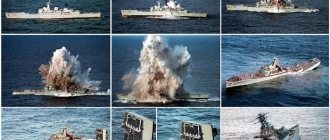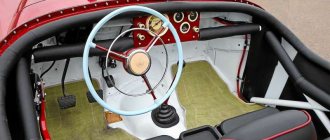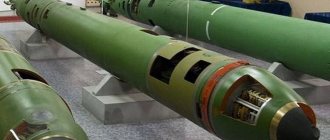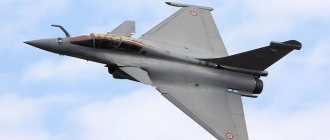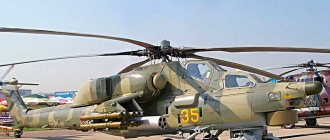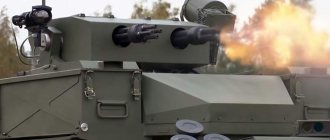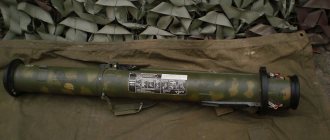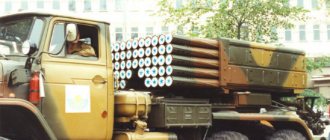From 1942 to 1945, during the fighting in the Pacific Ocean, American aircraft carrier groups were constantly subjected to air raids by the Imperial Japanese Air Force. As statistics show: aircraft carriers were often destroyed due to bombing and kamikazes, rather than heavy cruisers sunk by torpedo attacks and artillery of the Japanese.
Taking into account the experience of World War II, American minds came to the conclusion: it is necessary to develop air defense systems and aviation to protect their aircraft carrier groups.
In the brewing Cold War, Soviet engineers also took into account experience, only not their own, but American. Why climb on anti-aircraft pitchforks when you can strike from under water... With approximately the same thoughts in the depths of domestic research institutes, they began work on promising weapons for submarines, later, including work on the M-5 Shkval torpedo.
History of creation
From the late 40s to the 60s, development, research, and testing of torpedoes and engines for them were carried out, from Ladoga to Issyk-Kul, by various institutes. The main initiators of the idea were candidates L.I. Sedov and G.V. Logvinovich, professors of various fields of knowledge and Navy specialists.
The idea was the following - to create a high-speed torpedo, from which it would be impossible for a large ship to escape by maneuver.
In October 1960, after a resolution of the Council of Ministers of the USSR, work began on creating a torpedo moving at a speed of 100 m/s (approximately 360 km/h or 195-200 nautical knots). The speed of conventional torpedoes is no more than 20-25 m/s (60-70 km/h or 40-50 nautical knots).
The development was entrusted to NII-24 (now SNPP - “Region”) under the leadership of I. L. Merkulov. Information about the work on such a project in the USSR reached Western “friends,” but it had no effect other than laughter at the naivety of Soviet engineers.
The development of weapons of this level is a high-tech work, decades ahead of its time, as was believed in the United States.
To create such a weapon, it was necessary to combine the efforts of various industries, research into new technologies, develop new engines and fuel for them, and study fundamentally new physical phenomena in the underwater environment.
After a colossal amount of work, the Soviet M-4 submarine missile was tested from 1964 to 1972. Design errors led to the need to modernize this model. In 1977, the world's first jet torpedo, the M-5, underwent a series of state tests. The Shkval missile torpedo is entering service with the USSR Navy under the designation VA-111.
At this time, scientists from the USA are also making progress in this area - they prove that high torpedo speeds under water (in particular, up to 100 m/s) are theoretically possible.
Western submarines were already built using stealth technologies and had an advantage in stealth over their domestic counterparts. The Soviet submarine fleet, to some extent, leveled the odds by arming its submarines with high-speed torpedoes.
Supercavitating torpedo "Shkval": impressive, but not effective
The phrase in the title was said to representatives of the State Research and Production Enterprise "Region" by experts) at one of the naval salons in 1999. The opposite point of view of a fashion journalist (very little knowledge of the topic), columnist for The National Interest, Kyle Mizokami:
Russian supercavitating The Shkval torpedo destroyed the paradigm of submarine warfare. A weapon that can move six times faster than its predecessors is mind-blowing.
How are things really going?
First the story
The first projects of jet torpedoes appeared almost simultaneously with the “classical” torpedoes (here it should be noted that the underwater launch of missiles, at the time of the appearance of Whitehead’s self-propelled mine, had already been implemented in 1838 on our submarine by engineer-general K.A. Schilder).
Serious practical work on jet torpedoes began in the mid-30s.
(in relation to aircraft carriers and torpedo boats). In 1941-1951 at NII-400 (the future Central Research Institute "Gidropribor"), the development of an experimental model of a 45 cm caliber RT-45-2 jet torpedo with I. Isaev's liquid propellant rocket engine using nitric acid - kerosene steam was carried out. The assumed speed was 70-75 knots for a distance of 1.5-2 km. Due to the insufficient safety of the torpedo and the short range, the work was closed. At the same time, it was she who gave impetus to subsequent work on supercavitation in the USSR, the starting point of which was an internal memo, later one of the key developers on the topic, G.V. Uvarov, with an analysis of the complex of problems of the RT-45, and the conclusion that their a solution is possible only on the basis of a transition to a supercavitating product.
The first jet torpedo adopted for service was the aviation RAT-52 (chief designer Dillon G. Ya.), developed at NII-2 of the Ministry of Aviation Industry, with a powder jet engine. The PAT-52 turned out to be an original breakthrough product in the domestic torpedo building, where, in addition to the engine, such innovations as safe safety fuses, roll leveling, and a unified control system for the air and underwater sections (which they later preferred to forget until the present day!) appeared for the first time.
The most surprising thing is that the PAT-52 did not require complex maintenance and turned out to be very reliable, despite the fact that it was developed in an extremely short time (1947-1952). We have to really regret that its chief designer quickly passed away and did not manage to teach the torpedomen everything.
Il-28T in front of the suspension of the RAT-52 jet aircraft torpedo. 759 Khrabrovo airfield, late 60s.
In 1956, during the next reorganization, aviation torpedo topics from the Research Mine and Torpedo Institute (NIMIT) of the Navy were transferred to NII-15 of the Navy (later a branch of the Central Research Institute 30 of the Ministry of Defense), and NII-24 was first involved in the development of aviation jet torpedoes , and then the specially created Research Institute of PGM (hereinafter referred to as NPO "Region"). But these were “classical” torpedoes in terms of hydrodynamics, only with a jet engine, and they should be the subject of a separate (and interesting) conversation. Let's return to “supercavitation”.
At the end of 1946, at NIO-12 TsAGI, under the leadership of Major Engineer G.V. Logvinovich, seconded from the Navy. Applied research into the issues of torpedo weapon cavitation began. The first running model was tested by G.V. Logvinovich. and Uvarov G.V. in December 1952 under the ice of the Pirogovsky reservoir near Moscow.
An experimental model of the torpedo was created at the Research Institute-1 of the Ministry of Agriculture. The initial layout was proposed by G.V. Logvinovich: a disk, a profiled head part, a cylindrical part (with a fuel charge) and a converging aft part with torpedo-type stabilizers, rudders and a nozzle. The 1956 tests were unsuccessful. On the initiative of the chief engineer of NIMTI, A.I. Larionov. it was decided to install a “cable car” and launch products “tethered.” And again, failures and failures.
In 1957, the tests were stopped, but three stubborn enthusiasts, Alferov P.I., Uvarov G.V. and Libinshtein I.M., after analysis, they decided to return to launches in free motion (without a “cable car”), and success came, so far small - about 700 meters of linear movement at a constant depth in just over 6 seconds. Additional tests followed, the results of which led to the development of the RKT-45 cavitating jet torpedo for torpedo boats.
In 1960, Logvinovich G.V. prepared a report to the Navy command that advances in the field of high-speed hydrodynamics in combination with a highly efficient ramjet engine, in principle, make it possible to create a unique high-speed cavitating underwater missile.
The report hit the top ten, because the government had just issued a decree on the creation of an automated nuclear submarine of Project 705 (general scientific leadership: A.P. Aleksandrov and V.A. Trapeznikov). In addition, in the American magazine “Missiles and Rocket” for 1958, a program for creating new types of anti-submarine naval weapons in the United States was published, including data on the project of the EX-8 underwater missile, “equipped with a torpedo-type rocket or hydrojet engine , providing a speed of 150 knots and above.”
On October 13, 1960, the Decree of the CPSU Central Committee and the Council of Ministers was issued on the creation of a domestic high-speed torpedo “Shkval”. Work on the RKT-45 torpedo was stopped. Merkulov M.S. was appointed chief designer of Shkval. (from the “artillerymen” who were massively transferred to “rocketmen” at that time), scientific leadership was provided by NIO-12 TsAGI (A.B. Lotov, G.B. Logvinovich).
In addition, TsAGI began designing a large-scale reusable laboratory rocket - “model 205”, the layout of which (similar to the M-1, the first experimental model of the Shkval) included: - a rotary cavitator with a central hole for taking water into the sustainer engine; — ramjet engine designed by Merkulov M.S.; — detachable autonomous booster solid propellant rocket engine; — a system for blowing into the cavity using compressed air.
In 1961, launches of the 205 model began on the Moscow Sea. At first, the launches were successful. The “knockout” happened with the start of the flight phase; the 205 model lost control and lost air. The launches of the M-1 rocket were also unsuccessful.
Taking into account the entire burden of responsibility, the Resolutions of the CPSU Central Committee and the Council of Ministers, discussions of the current situation were extremely acute and not always scientific and technical. Representatives of the Ministry of Shipbuilding and Industry demanded the transfer of R&D to R&D (for the practical nuances of carrying out R&D and R&D, see the material “Torpedo SET-53: Soviet “totalitarian”, but real”
), or even better, a complete cessation of work. In contrast to it was a group from the USSR Academy of Sciences, consisting of leading specialists and academicians V.A. Trapeznikov, A.A. Mikulin, Kh.A. Rakhmatullina.
But theoretical science could not help here; success came after TsAGI experiments in studying the processes of starting an engine in a cavitation cavity. The need to make fundamental changes to the 205 model and the M-1 product became clear. This was done in the shortest possible time, right on the test site. The accelerating stage was combined with the main engine. The acceleration stage was now located in the sub-caliber part and connected to the combustion chamber of the main engine; a single supersonic nozzle was installed, which ensured the continuous flow of gases in the acceleration and main stages.
The test results were positive. The Shkval variant with this arrangement received the designation M-3. Since May 1963, regular launches began from a test stand on Lake Issyk-Kul.
4 years had passed since the start of the work, but its complexity was such that there were another 13 years of work ahead (i.e., the total development time (R&D) of Shkval was 17 years). Ex-deputy head of the Navy Anti-Submarine Weapons Directorate R. A. Gusev wrote:
Publications on EX-8 ceased. It can be assumed that the Americans got to these problems and stopped. They are pragmatists. We are romantics. We need speed like air. We need a bird-three, even underwater.
In 1967 Merkulov M.S. was replaced by V.R. Serov, who soon (but not for long) became the head of the created Research Institute of PGM (the future “Region”).
In 1969, the Shkval variant M4-1-M covered its full range for the first time in accordance with the TTZ (tactical and technical specifications for the design and development work). The Research Institute of PGM was strengthened by rocket scientists with the replacement of Serov by A.I. Zarubin. (Director of the Research Institute of PGM) and Rakova E.D. (chief designer of R&D), who ensured the completion of the development of Shkval. The Shkval anti-submarine complex with the M5 missile was adopted by the Navy on November 29, 1977.
M-5 "Shkval".
Gusev R. A.:
I decided to find out from G.V. Uvarov how and why the chief designers changed three times during the creation of Shkval. He was brief: “All three played a significant role in the creation of the underwater missile.” But I would give first place to M.S. Merkulov. Under him, the main scientific and technical problems were solved, and the appearance of the underwater missile was formed. - Why was it replaced? — I would say that he did not work well with the leadership of TsAGI. At that time, the head of TsAGI was V.M. Myasishchev, a famous aircraft designer... Myasishchev intuitively felt that the chief designer should interact more closely with TsAGI. After some time, V.R. Serov became the director of NII-24. Appointed for scale. He worked for V.P. Makeev, and it was rumored that their partnership did not work out. Serov was the smartest person, focused on the future, but with a Napoleonic character. It seems to me that his character ruined him. After some time, the development of Shkval was continued by D.E. Rakov, and Serov took up the future: under him, the Research Institute of PTM was created. Rakov made his creative contribution by creating another modification of the rocket, now the M-5, under the banner of increasing reliability, manufacturability, etc. But our paths here decisively diverged. By this time, Logvinovich had slightly pushed me aside as a possible competitor. But, just so you know, I firmly stand on the position that Rakov and Logvinovich have significantly increased the development time...
Result of "Shkval"
200 knots under water, and even at 10 km, is certainly an outstanding result.
The only problem is where to put it. Initially, “Shkval” was based on the 705 project, which had unique high-speed and maneuverable characteristics, and as an example of a high-speed underwater weapon that complemented the “Vyuga” anti-submarine missile (ASM) (which actually “closed” its “dead zone”). It was as part of the project 705 combat complex that both “Blizzard” and “Shkval” were “a single whole”, and were effectively provided with target designation by the powerful sonar path of the Okean State Joint Stock Company.
Here it is necessary to take into account that in the US Navy since the mid-60s. The Sabroc anti-aircraft missile system was in service (only with nuclear weapons - nuclear warheads). A war with the United States was then considered exclusively with the use of nuclear weapons.
However, the mass production series of the 705 project did not take off, and all other projects experienced acute bottlenecks of the Shkval, primarily significant restrictions on the launch depth, the post-launch turn angle, and only the nuclear option. When in the overwhelming majority of cases, for the same 671RTM, the battle will begin with the acoustics report “Torpedo on the right 90!!!”, “Shkval” (which in this situation simply cannot be used) turns from a weapon into ballast, which simply takes up (and crosses out for the battle ) torpedo tube (TA). And if there are two Shkvalov on the boat, then minus two TAs (at the request of the relevant authorities, underwater weapons with nuclear warheads of the Navy were stored only in TAs).
Surface attack? However, a distance of 10 km left our submarines little chance of secretly approaching it against ships with good hydroacoustics.
High-speed underwater missiles (SPR) are fatally inferior to SLR in terms of range and ensure the minimum time for delivery of the warhead to the target.
“Shkval” and PLR 84RN, display of equipment for Navy Day 2022, Arkhangelsk. The PLR range is approximately 4 times greater than that of the Shkval
The thesis about the “under-ice use” of the Shkval is not justified due to the very small marching depth of the Shkval and the unacceptably high probability of a collision with ice. This problem was understood, and one of the directions for the development of the SPR immediately became an increase in the marching depth, but this required a significant increase in speed, and therefore new energy requirements (which were already limiting for a 53-cm product, for example, Shkval had a mass of 2 .7 t with the mass of the SET-65 torpedo 1.7 t).
"Shkval-E" and UGST, the range differs by about 5 times
However, the most critical issue was that the effective firing ranges of Western submarine torpedoes (with remote control) were significantly greater than the full range of the Shkval. Those. The US Navy submarines had the opportunity to shoot our submarines with torpedoes and Shkvals with impunity from a safe distance (they were only afraid of the submarines). The 65 cm caliber SPR would have had some capabilities, but they never appeared, and today in the Navy “thick” TAs are generally anathema.
Along with all this, “Shkval” became a powerful PR factor, even during the times of the USSR. The extremely difficult situation with torpedoes of the USSR Navy was realized, incl. and at the top (in the Central Committee of the CPSU), and then the fleet, for a cheerful report, extracted an argument: not everything is bad, we have Shkval, but the USA does not.
Here it is appropriate to recall the espionage case of E. Pope (2000) about the alleged attempts of the United States to seize the secrets of Shkval. In reality, at the time of 2000, the US “Shkval” was simply uninteresting. There are good reasons to believe that the United States had not only documentation on it, but also samples... At the same time, it would not be a bad idea for domestic specialists (and representatives of the relevant authorities) to figure out for themselves (for the benefit of the cause) what Pope was really interested in (and in what corner the topic these works, where we were once in the lead, ended up with us).
In 1995, at the international arms exhibition in Abu Dhabi, the State Research and Production Enterprise "Region" presented an export version of the SPR - "Shkval-E". The nuclear warhead was replaced by a conventional warhead with a TNT equivalent of just over 200 kg for hitting surface targets. Taking into account the lack of a homing system, the effective range of the Shkval-E did not exceed 7 km.
Development of "Shkval"
The development of the subject of SPR in the USSR continued continuously, and new versions went into work even before the completion of the Shkval design and development work.
In this case, the main direction was to increase the speed up to more than 150 m/s (300 knots), increase the depth (march and launch), expand the conditions of use and the possibility of using a non-nuclear warhead (with homing). The search was carried out across the widest range of possible options, sometimes bordering on the fantastic. In the form of specific projects, work was carried out on the topics “Shkval-15” and “Shkval-15B” with the release of a new generation of SPR with dramatically improved performance characteristics. Work on Shkval-15B was crippled in the 1990s; unfortunately, much that was necessary and useful was missed. “Shkval-15B” became the swan song of G.V. Uvarov. People who worked with him noted his extremely objective view of the topic, his extremely critical attitude towards “satisfying scientific curiosity at public expense.”
From today's perspective, it is regrettable that Shkval-15B was not completed; it was the maximum that was really possible, but at very moderate costs. Moreover, the combat equipment for this SPR was extremely promising for a number of other Navy topics. But in the 90s, in order to survive, enterprises had to cut to the quick. We chose the theme of anti-torpedoes (“Lasta”), which later became both “Package” and “Physicist”.
From the book “Science of St. Petersburg and the sea power of Russia.” St. Petersburg, 2002
In the 2000s, when funding became more free, work on the topic continued, but with all the specifics of new economic conditions. And this was manifested in all its color and aroma in the “Predator” theme (more on this later).
From the passport of the innovative development program of JSC Tactical Missile Weapons Corporation for the period until 2022:
For underwater high-speed missiles. 1. Combat equipment that ensures high efficiency of destruction of NK in the minimum permissible time. 2. Covering the distance to the target at a given depth with a high average trajectory speed in the mode of developed cavitation. 3. Magnetometric guidance system, which makes it possible to determine with high probability the moment of passage in the target area and give a command to separate the combat equipment.
During the military-technical forum “Army-2015”, a round table “Marine underwater weapons (MWS): realities and prospects” was held, among the reports was a speech by the chief designer of OJSC State Research and Production Enterprise “Region” I.V. Garanin. "Prospects for the development of high-speed underwater facilities." The report (like the entire topic of the round table) caused heated discussion, including resonance in the media. The author’s position was stated in the article “Russian underwater weapons today and tomorrow. Will there be a breakthrough from the torpedo crisis?
.
High-speed underwater missiles (SPR). The main conceptual flaw in the development of the SPR is that the effective ranges of a salvo of enemy torpedoes already from the beginning of the 80s of the last century significantly exceeded the effective firing distances of the SPR. Those. the enemy had the opportunity to secretly fire torpedoes from a safe distance. In addition, in “clean water” conditions, anti-submarine missiles are completely inferior (in terms of time to deliver the warhead to the target) to anti-submarine missiles. In fact, the only tactically sound area for their use is the Arctic. At the same time, for a long time, the most interesting and promising direction in the development of supercavitation ammunition remained underestimated - “small-caliber”, in which the West successfully worked. Among the positive things in the reports of the Army-15 round table, it should be noted that the prospects of the “small-caliber direction” of the SPR are recognized by leading domestic specialists.
At the same round table, a report was made by V.V. Averkiev, director of NPK Max, OJSC NPP Radar MMS. “Magnetometric guidance systems for naval underwater weapons in conditions of massive hydraulic counteraction. Theory and results". With a rather scandalous discussion. From the article “Russian underwater weapons today and tomorrow. Will there be a breakthrough from the torpedo crisis? about the magnetometric guidance system:
...discussion on one of the “innovative detection systems”, which the 1st Central Research Institute “stuck” into almost all current R&D projects. At the same time, the head of the development organization admitted that from the real reserve there are only “mathematical modeling results”, from which it follows that the maximum range of such equipment is very limited. At the same time, its implementation was used by some “specialists” to justify the cessation of promising research work on the subject of acoustic SSN! As they say, a mistake is worse than a crime! Although... maybe the fact is that the head of the torpedo department of the 1st Central Research Institute defended his dissertation on precisely this “innovative topic”? As a result, significant government funds were spent, scarce R&D equipment was used to test these “scientific research” with obviously dubious effectiveness, and R&D that the fleet really needed was thwarted simply on the basis of “mathematical modeling” (i.e., without real tests on prototypes!) . At the same time, there is indeed an area of effective application for this equipment, but instead this equipment is prescribed for obviously non-optimal areas.
The article did not indicate the most scandalous moment of this discussion: Navy specialists and Mr. Averkiev stated that it was allegedly impossible to counter such equipment with hydroacoustic countermeasures (SGPD), and this was cheerfully reported to the leadership. In fact, this was just a play on words: SGPD, as a rule, were means of hydroacoustics, and, accordingly, could not influence magnetometric means.
The only problem was that a number of Western SGPDs (for example, the Mk30 simulator) have, in addition to acoustics, a magnetometric simulation channel (for testing aircraft using them). At the same time, the same Mr. Averkiev, during a round table, declared the “need to create simulation tools” to test his magnetometric channel, and this was done an hour after the statement about the “impossibility of this”! When the author asked how such contradictory statements fit together, the answer was painful silence. Actually, everything was clear to everyone.
From the article “Russian underwater weapons today and tomorrow. Will there be a breakthrough from the “torpedo crisis?”:
The author was directly related to events related to MPO and the development of the MPO concept, since since 2007 he has worked closely on this topic with Advisor to the Minister of Defense of the Russian Federation, Admiral G. A. Suchkov. Taking into account the critical situation with the Navy MPO, Admiral Suchkov submitted a memo to the Minister of Defense of the Russian Federation in 2007. Without touching on the issue of Serdyukov’s numerous mistakes (including in terms of the clumsy reform of the command and control bodies of the RF Armed Forces), in that situation he behaved like a normal defense minister: give a concept (“business plan”), “there will be funding for it.” However, the development and approval of the MPO concept was then disrupted. This was primarily due to the intrigues of certain individuals and organizations, taking into account the fact that a number of decisions planned by the Navy’s Anti-Submarine Weapons Directorate (USA) (in particular, on the “Physicist” torpedo) were radically at odds with their financial interests.
One of these intrigues became the Predator OCD. Alas, instead of the maximum possible from the technically real, which was in “Shkval-15B”, “Predator” initially had maximum opportunities for the development of budget funds by the necessary persons (here there is a far-fetched magnetometric system, behind which the ears of a significant number of people with shoulder straps stuck out and without, prepared to master the sweet budget pie).
The author formed a harsh and negative attitude towards the Predator during the period of work on projects for the concept of naval underwater weapons with Admiral Suchkov. Lobbyists for this topic tried to justify “theirs”, even to the point of almost completely replacing torpedoes and anti-ship missiles with Predators.
Moreover, the Predator R&D, opened in 2009, turned out to be not only terribly expensive, but also, in fact, the only serious R&D on the subject of underwater weapons at that time. At the same time, we had a catastrophic situation with torpedoes, not only due to their military-technical backwardness, but also simply by their availability... At that time, it got to the point that our submarines went into combat service with only a few torpedoes in their ammunition load. And in this situation, the Predator was nothing more than a feast during the plague.
Yes, in this situation they tried to put some very necessary and correct things and developments into it... But for some reason they were “lost” in the process, despite the fact that without them the ability of the “Predator” to work as intended raises serious questions.
"Answer", "Package", "Predator". Names of topics to which the author’s attitude is obvious (the answer is the severed head of the “Predator” in the “Package”, if someone did not understand). The reaction of specialists to the drawing (from the author’s office, 2012) was the most positive, but in the form of laughter through tears
In 2016, the name of the theme “Predator” appeared in the media.
JSC KB Elektropribor (Saratov) submitted an application-presentation
for participation in the Aircraft Builder of the Year competition, based on the results of 2015, held by the Union of Aircraft Manufacturers of Russia.
Since 2013... carried out within the framework of the state defense order for the implementation of the Predator development work. At the end of 2016, it is planned to conduct preliminary tests of the component part of the underwater missile, including sea trials of the device, based on the results of which the design documentation for the component part of the underwater missile will be assigned the letter “O”.
Our popular media did not lose face. Headlines like: “Predator” is the ideal aircraft carrier killer. The Shkval is being replaced by an even more powerful rocket torpedo...
What's the end result? Especially considering that it’s 2022, and the “O” (i.e., completion of preliminary tests and transition to the state stage) was promised by the participants in this process back in 2016? And as a result, today there are arbitrations.
For example, case No. A57-15277/2019
.
As follows from the case materials, on May 3, 2013, agreement No. 130-VP-1 was concluded between OJSC Gavrilov-Yamsky Machine-Building (Contractor) and OJSC KB Elektropribor (Customer) to perform an integral part of the development work. According to clause 1.1 of the contract, the Contractor undertakes to complete and timely deliver to the Customer in accordance with the requirements and terms of the contract and the Statement of Execution, and the Customer to accept and pay for the component part of the work “Predator-OKP” “Development of pneumatic units PGS product VA-411”... carried out within the framework of the state defense order and agreement dated November 12, 2009 No. 253/08/8/K/0013-09 for the work “Predator”, concluded between the Ministry of Defense of the Russian Federation and OJSC State Research and Production Enterprise Region (Resolution of the Government of the Russian Federation dated December 29, 2009 No. 1036-55, dated August 12, 2009, No. 658-21).
All this is very sad, and not only because huge funds were “gobbled up” (and at a time when there was a critical shortage of them for torpedoes), but also because the chief designer of the Predator is an outstanding and promising specialist and leader . Unfortunately, we now have very few queens, but too many of those about whom they say “the product is afraid of water, because its chief designer is afraid of water” (in this particular case, sea trials were meant).
At the same time, you need to understand that queens do not grow on trees, and their potential can only be revealed as a result of thoughtful, reasonable and hard work to create something new. Young Korolev S.P. was a completely different person (sometimes with very ambiguous actions and decisions) than the “chief” Korolev, known to the whole world.
Alas, Predator OCD is not the topic that shapes queens.
What to do with it now? Bring it on. And not in the form of “the third grade is not a defect,” as they are trying to do today, but starting with an objective disclosure of all problems and their objective assessment, the removal of all “cutting” points from the requirements for the product, but the unconditional fulfillment (and real confirmation!) of those , which are key in battle.
There is still some usefulness of such products, and not only in the Arctic. The same Sea of Okhotsk in winter is covered with ice over a significant part of the area. However, it is necessary to clearly and fundamentally realize that the 53 cm caliber SPR, due to the significant lag in range of use from torpedoes, can only be considered as an auxiliary weapon in combat.
Here it would be appropriate to quote a phrase from a major domestic specialist in the subject, said at the beginning of 2010:
We made a strategic mistake by chasing monsters. All the fun in supercavitation is in small calibers.
What’s interesting is the possibility of all-depth movement (and not the constant and extremely shallow depth of “monsters”), active maneuvering, and installation of homing systems. However, this was possible only on products of a significantly smaller caliber than 53 cm. There was a certain reserve in this part - these were aircraft anti-submarine missiles, in some cases going into a “semi-cavitation mode”. However, we have not taken decisive steps for full-scale work in this direction...
Supercavitation in so-called partners. West and East
From Jane's International Defense Review, December 2001:
As part of the Supercav program, the Undersea Warfare Research Center is testing technologies for high-speed (more than 200 kt) supercavitation weapons, the full-scale demonstration of which could be carried out in five years. It is possible to use this weapon to create anti-torpedoes and a promising light torpedo. Currently, the Research Center is working on creating a full-scale sample of a supercavitation projectile mated with the ASROCVL (VLA) anti-submarine missile without a Mk-46 torpedo, instead of which a “Supercav” is installed, which will have an underwater speed of more than 200 knots. at a distance of 2750 m. The head of the projectile is covered with a conical cavitator, which can carry an array of sensors including more than 120 broadband hydroacoustic elements to ensure target acquisition at a distance of more than 900 m.
Unlike our “monsters,” R&D on the topic of supercavitation in the USA went in the direction of the most effective topics. It was the same in Germany, which conducted similar studies. Taking this factor into account, at a certain stage, work in the USA and Germany was combined, but so far it is being carried out only at the level of experiments and development of scientific groundwork.
Layout and section of the Barracuda supercavitating torpedo (Germany, USA)
Taking into account the sufficient effectiveness of small-sized torpedoes, there is no need for supercavitating weapons yet. For now... But the development of torpedo defense systems significantly changes this situation. Today, an attacking small-sized torpedo is very likely to be destroyed by an M15 anti-torpedo, but it can hit an object at a speed of more than 200 knots. impossible.
Accordingly, Western countries are forming the necessary scientific and technical groundwork in order to transfer it into real R&D at the right time.
Work on this topic is also being carried out in China, which is confirmed by some extremely fragmentary information from the “Chinese Internet”.
From Chinese works on supercavitation
At the same time, it is necessary to objectively understand that China, both “semi-officially” and through intelligence services, received a very large amount of information on Shkval from Kazakhstan and Kyrgyzstan (the media mentioned the delivery of 40 Shkval missiles by Kazakhstan).
As for the “Iranian supercavitating torpedo,” it will be enough to simply provide a photograph of it:
The fact is obvious.
Ultra-small calibers
From the article “High-speed underwater missiles of submarines” by E. S. Shakhidzhanov and Yu. V. Suslov:
Research work of the 80s. against small-caliber missiles, underwater NURS (PNURS) which, with target designation, are a highly effective and cheap means of anti-torpedo protection... testing entry without ricochet for two-medium small-caliber vehicles... PNURS with speeds of 250-300 m/s or more from the air against underwater targets and vice versa.
Gusev R.A:
Submarine missiles, in particular, will be up to the task of ensuring self-defense of submarines from enemy torpedoes in the future.
Echoes of those works:
Those. at the turn of the early 90s. we were certainly and significantly ahead of everyone else.
And now? And now we are chasing “monsters” (more precisely, the abundant use of budget funds for “monsters”.
At the same time, in the USA and a number of other countries (for example, Norway, DSG):
Real work of the US Navy to provide anti-torpedo protection with supercavitating ammunition
The author touched upon this topic lightly and ever so slightly in 2015 in the article
“A shell for each torpedo
.
Separately, it is necessary to touch upon the supposed US Navy RAMICS anti-mine system with a laser ranging station for supposedly detecting mines and destroying them with supercavitating projectiles.
The problem is that, according to competent domestic specialists, the RAMICS laser station, by its design features, is primarily an anti-submarine means of detecting the “trace” of a submarine. Accordingly, our specialists have good reason to think hard about the real (and not declared) purposes of the RAMICS gun.
Why is this question being raised in a public article? But because these questions were put to those “who are supposed to” many times. With near-zero results...
A conversation with “modern specialists” of the Russian Navy at the Army 2020 forum on this topic evoked an interesting reaction:
- What, did we have something on this part?
- Actually, it was, and with a huge statistics of work, only it managed to become covered with a thick layer of dust (although, most likely still working) in anticipation of the attention of the customer (to whom this was reported many times).
conclusions
If at the beginning of the 90s.
We were undoubtedly and significantly in the lead in the field of supercavitation, but today we have been objectively and significantly surpassed by foreign competitors. Today, three main areas of work have emerged: - large-sized products of 53 cm caliber (“Shkval”, “Predator”), capable only of rectilinear movement at shallow depths with the possibility of being equipped with “passengers” such as nuclear warheads or a conventional small-sized torpedo (which is the emphasis of us); — small-sized, all-depth maneuverable products with homing systems (which is emphasized in the West); — ultra-small products of the “cannon shell” type (where we were in the lead for a long time, but today we have completely given this subject to the West).
The key reason for the emerging and already significant lag is the unreasonable reliance on 53 cm caliber “monsters”, despite the fact that they are obviously defective and are inferior to torpedoes and anti-submarine missiles in most tactical situations, even to the point that our submarines with “Predators” the enemy can fire torpedoes from a safe distance with absolute impunity.
The highlight of 150 kilotons and torpedo design
Speed and engine
General description of the external ballistics of the torpedo: high speed is provided by the jet engine, and water resistance (1000 times greater than resistance in the air) is overcome thanks to the air “cocoon” enveloping the entire body (8.2 m in length). It follows from this that this is an ordinary rocket floating under water.
There are two engines: booster and sustainer.
The booster (starter) runs on liquid fuel for 4 seconds, launches the missile from the torpedo tube, and then undocks.
The marcher begins work - it reaches cruising speed and delivers the cargo to its destination. Solid fuel - metals (lithium, magnesium, aluminum) that react with the oxidizing catalyst - water. The enormous noise of a fired torpedo is one of the main drawbacks, immediately revealing the submarine.
An air “cocoon” (cavity) is a gas shell created by a special gas generator. The gas is released onto the body and distributed by a cavitator located in front of the “head” of the torpedo.
I see a purpose, but I do not see obstacles
The navigation system uses a program that is set immediately before the torpedo is launched.
Following the specified target coordinates, the weapon moves following a route and maneuvering four small rudders.
Along the way, she cannot be distracted by any interference or devices - she floats where she was told and that’s it. The lack of a homing system is the second of the main drawbacks.
Surprise on board
The warhead uses 210 kg of conventional explosives or 150 kilotons of nuclear explosives. Detonation of a nuclear warhead, even close to an enemy ship (within a radius of 1000 m), has dire consequences.
Namely, destruction of external deck devices, light weapons from the shock wave and the possibility of damage from an electromagnetic pulse. After such an attack, you should go, if not to the bottom, then at least for repairs.
Feasibility of launch
The cost of launching a torpedo will include not only the production of the torpedo itself, but also the submarine and the value of the entire crew. The range is 14 km - this is the first main drawback.
In modern naval combat, a launch from such a distance is suicidal torpedoing for the submarine crew. Of course, only a destroyer or frigate is capable of dodging the “fan” of launched shells, but it is also unlikely to escape from the scene of the attack, within the coverage area of the escort of an aircraft carrier and carrier-based aircraft.
Advantages of NRK SHKVAL
- High productivity – at least 400 l/sec.
- A comprehensive solution for collecting and pumping large volumes of water over long distances, including when eliminating the consequences of floods.
- Quick deployment of the complex into working condition.
- Can be used in shallow water.
- High efficiency in fire extinguishing, which is achieved by supplying a large amount of water.
- Fast laying of hose lines over long distances.
- Mechanized assembly of a hose line.
- Efficiency by reducing the time required to respond to emergencies.
- Supplying water over many kilometers.
- Laying hoses across roads.
- Possibility of use in cases of difficult access to a water source.
- Possibility of pumping large volumes of water when eliminating the consequences of flooding.
- Can be used in shallow water.
The technical, social and economic effect of using a universal pump-hose complex should be ensured by the effectiveness of fire extinguishing in difficult terrain, by reducing fire extinguishing time and by reducing damage from fires.
Specifications
Tactical and technical characteristics of the Shkval torpedo missile:
Caliber - 533.4 mm; Length - 8 meters; Weight - 2700 kg; The power of the nuclear warhead is 150 kt of TNT; The mass of a conventional warhead is 210 kg; Speed - 375 km/h; The range of action is about 7 kilometers for the old torpedo, and up to 13 km for the modernized one.
Differences (features) of the performance characteristics of Shkval-E:
Length - 8.2 m; Range – up to 10 kilometers; Travel depth - 6 meters; The warhead is only high-explosive; Type of launch - surface or underwater; Underwater launch depth is up to 30 meters.
Launching torpedoes from a submarine
The torpedo is called supersonic, but this is not entirely true, since it moves under water without reaching the speed of sound.
Possible modifications
Modernization of the hydrojet torpedo is one of the most important tasks of weapons designers for the Russian naval forces. Therefore, work to improve Shkval was not completely curtailed even in the crisis of the nineties.
There are currently at least three modified "supersonic" torpedoes.
First of all, this is the above-mentioned export variation of Shkval-E, designed specifically for production for sale abroad. Unlike a standard torpedo, the Eshka is not designed to be equipped with a nuclear warhead and destroy underwater military targets. In addition, this variation is characterized by a shorter range - 10 km versus 13 for the modernized Shkval, which is produced for the Russian Navy. Shkval-E is used only with launch systems unified with Russian ships. Work on the design of modified variations for the launch systems of individual customers is still “in progress”; Shkval-M is an improved variation of the hydrojet torpedo-missile, completed in 2010, with better range and warhead weight. The latter is increased to 350 kilograms, and the range is just over 13 km. Design work to improve weapons does not stop. In 2013, an even more advanced one was designed - Shkval-M2. Both variations with the letter “M” are strictly classified; there is almost no information about them.
Shkval-M modification at a weapons exhibition
